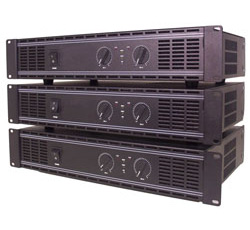
Amplifiers are rated for power generation. Loudspeakers are rated for power dissipation. Loudspeakers are notoriously inefficient devices – they waste almost all of the of the power delivered from the amplifier. Their power rating describes the amount of continuous power that can be dissipated in the form of heat without damage to the loudspeaker.
While at first glance it may appear that more power dissipation is better, this is only true if the method used to achieve it does not compromise the efficiency of the loudspeaker. The ideal loudspeaker can produce the desired sound level using as little power as possible. There is less heating due to the higher efficiency.
There is nothing impressive or inherently beneficial to driving lots of power into a loudspeaker. It is more impressive to get lots of sound with less applied power. Think of mileage ratings for automobiles and you have the right idea.
It’s more about efficiency than consumption. Horn loading, boundary placements and manifolding are methods of increasing loudspeaker efficiency, allowing more sound per the applied voltage (and ultimately the applied power).
It is a mistake to associate the power rating of the loudspeaker with its sonic performance. Higher power dissipation ratings simply mean that the loudspeaker can dissipate lots of heat.
But power ratings by themselves give no indication of efficiency in producing acoustic power, which is the purpose of the loudspeaker. It is possible to increase the power dissipation rating of the loudspeaker by reducing its efficiency.
One could simply add some resistive elements internally. The result is a very large power rating but very little sound – not what we’re after!
The Proper Perspective
Let’s say that your sound system needs to deliver 100 dB (SPL) to the audience. That’s very loud, so one might assume that they need a loudspeaker with a large power rating to get it.
Not so – you need a loudspeaker with high efficiency and sensitivity so that it can produce the desired level without getting too hot. Rather than saying “Wow, the Killsound 5K handles 5000 watts!” it would be better to ask “Why do I have to feed 5000 watts to the Killsound 5K to get 100 dBSPL in the audience? The Efficienator 1 can produce that level and only have to dissipate 100 watts!”
A more meaningful loudspeaker rating would be that of maximum SPL. This rating can be found by scaling the loudspeaker’s sensitivity rating by the maximum input power rating. This rating allows a loudspeaker with a lower power rating, but higher sensitivity to compare favorably with a loudspeaker with a higher power rating but lower sensitivity.
It is unfortunate that misunderstandings about power ratings have precipitated an arms race among manufacturers to provide large numbers. Big power ratings are an easy sell, but high efficiency is a better goal.
The Power Test
The only reason to “power test” a loudspeaker is to determine its thermal limits. Many methods exist for determining the maximum input power. All of them have merits, and all have similar attributes.
